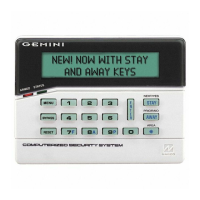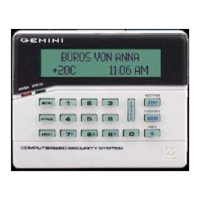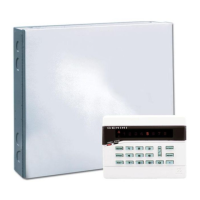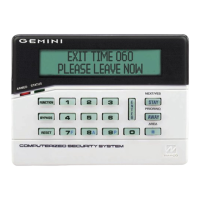NAPCO Gemini C-Series Control Panel Installation Instructions--Volume 2
Installation Instructions, Volume 2 Page 31
FIRE GLOSSARY
ABLE. When disabled, the output will not function and a trouble will be generated until it is re-enabled with the same proc-
ess. Only the four integral NAC A through NAC D circuits or the following external output devices addressed as 1-40 may be
programmed to report trouble:
NAC A through NAC D, FWC-FSLC-SOM1, FWC-FSLC-RM2 (Relay 1), FWC-FSLC-RM2 (Relay 2)
NAC Output Events
Output Events are programmed in the NAC/Output Assignment screen; program an Event and a Timeout duration. If the
timeout is set to zero, the Event is untimed and thus requires the system be silenced or reset from the unlocked GEMC-FK1
Fire keypad in order to turn off a Fire output (depending on the output programming).
NL-MOD IP Address, Panel IP Address (see the Burglary Glossary)
NL MOD Port Number
Panel Port Number - This is the port number where the Quickloader for Windows can accept the panel. The NL-MOD must
be configured to include this number.
NL-MOD Setup
See the GEMC-NL-MOD installation instructions (WI1754).
OMT
One Man Test
Both sensor devices and sounders can be tested by a single installer, without the need to return to the control panel between
testing each device. After the first device in a zone is tested, the sounders give a short response and the system resets auto-
matically, allowing the installer to proceed directly to the next device. In this mode, sounders operate for about .5 seconds (1
ding) when sensor is triggered and when sensor resets it operates for 2 dings.
Program as follows:
1. Unlock the keypad using the Master Security Code or Dealer Keypad Program Code. "Keypad Unlocked" flashes
momentarily on the keypad LCD.
2. Press NEXT and PRIOR to scroll through options until "Do One Man Test" displays.
3. Press ENTER. System trouble "One Man Test Mode, System Offline" appears (with TROUBLE icon) indicating the
system is in Test Mode and will not function as intended. If programmed, a report will be sent to the central station (in
Quickloader, see the System Assignment screen, System Reporting and Outputs tab).
4. Activate each initiating device one at a time (for example, blow smoke into the smoke detectors, activate each pull-
station, etc.). When detected by the system, all output circuits programmed to activate when the associated zone is in
alarm will sound a single momentary chirp.
5. Restore the device (blow clean air through the smoke detectors, restore each pull station, etc.). When the system de-
tects the zone restored, all associated zones will sound 2 short chirps.
6. When all Fire devices have been tested and the mapped outputs confirmed, end the One Man Test mode by unlocking
the GEMC-FK1 Fire keypad, then press RESET.
NOTE: Pressing RESET on any keypad will end the One Man Test mode.
Output Control (External Outputs, External Relays)
In addition to the three relays provided on the motherboard, up to 88 external outputs are supported. These outputs can be
on the GEMC-RM3008, GEMC-OUT8, FWC-FSLC-SOM1 and FWC-FSLC-RM2 (supported by the GEMC-FW-SLC module).
These external outputs may be controlled from the keypad, by an event or by a schedule, through the use of PCD-Windows
Quickloader download software. Program these outputs to activate by event in the PCD-Windows NAC / Output Assign-
ment screen. Refer to the Fire Output Option chart and the Fire / Burg Output Device chart.
Panel Relay Fire Trouble Relay
When enabled, the Gemini C-Series control panel motherboard NAC Output Relay #5 trips on a Fire Trouble. Operates
"normally energized". Enable in the NAC/Output Assignment screen, NAC/Output Options tab.
PC Security Code (see the Burglary Glossary)
Pre-Alarm Warning See the Burglary Glossary. (Not for UL applications; do not program Fire zones with this feature).
Pre-Dial Delay
A Pre-Dial Delay duration may be used whenever a delay is required before dialing. It may be required when programming
Dial-Tone Detection, which causes the communicator to wait before it attempts to detect a dial tone (see Dial-Tone Detec-
tion). Certain telephone exchanges send a nonstandard dial tone that the communicator may not be able to detect. With
these nonstandard exchanges, it is possible to program Pre-Dial Delay rather than Dial-Tone Detection. This will cause the
communicator to wait for a predetermined period of time before dialing rather than look for a nonstandard dial tone.
Contact the telephone-equipment supplier to find out how long a delay is required before dialing. Select Pre-Dial Delay by
programming one "D" for each 4-second delay required immediately before the telephone number. Note: In UL installations,
